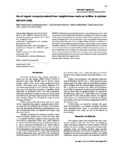Por favor, use este identificador para citar o enlazar este ítem:
http://www.alice.cnptia.embrapa.br/alice/handle/doc/1026693Registro completo de metadatos
| Campo DC | Valor | Lengua/Idioma |
|---|---|---|
| dc.contributor.author | NUNES, W. A. G. de A. | pt_BR |
| dc.contributor.author | MENEZES, J. F. S. | pt_BR |
| dc.contributor.author | BENITES, V. de M. | pt_BR |
| dc.contributor.author | LIMA JUNIOR, S. A. de | pt_BR |
| dc.contributor.author | OLIVEIRA, A. dos S. | pt_BR |
| dc.date.accessioned | 2015-10-19T11:11:11Z | pt_BR |
| dc.date.available | 2015-10-19T11:11:11Z | pt_BR |
| dc.date.created | 2015-10-19 | pt_BR |
| dc.date.issued | 2015 | pt_BR |
| dc.identifier.citation | Scientia Agricola, Piracicaba, v. 72, n. 4, p. 343-350, jul./ago. 2015. | pt_BR |
| dc.identifier.uri | http://www.alice.cnptia.embrapa.br/alice/handle/doc/1026693 | pt_BR |
| dc.description | Slaughterhouses generate large amounts of rumen content and its use as a fertilizer may offer an environmentally friendly strategy for its management. The effect of an organic fertilizer produced from slaughterhouse waste on the fertility of sandy and clayey soils as well as soybean yield (Glycine max L.) and corn (Zea mays L.) crops was evaluated. Field experiments were set up and five rates up to 16 t ha-1 of organic fertilizer (293 kg ha-1 N, 334 kg ha-1 P and 27 kg ha-1 K) were applied annually, before sowing in spring/summer, as well as a mineral fertilization of 300 kg ha-1 in the formulation 2-20-20 for soybean and 300 kg ha-1 of 12-15-15 for corn. The organic fertilizer changed soil fertility in the field experiments by increasing pH, Ca, Mg, K, P-Mehlich and P-resin. Such effects were more evident in the sandy than in the clayey soil, and the most superficial layer was affected more. The organic fertilizer rate needed to achieve maximum yield decreased for corn in both soils and for soybean in the sandy soil, although the amounts required may still be regarded as high. | pt_BR |
| dc.language.iso | eng | eng |
| dc.rights | openAccess | eng |
| dc.subject | Resíduo de matadouro | pt_BR |
| dc.subject | Adubação orgânica | pt_BR |
| dc.subject | Reciclagem de nutrientes | pt_BR |
| dc.title | Use of organic compost produced from slaughterhouse waste as fertilizer in soybean and corn crops. | pt_BR |
| dc.type | Artigo de periódico | pt_BR |
| dc.date.updated | 2016-02-01T11:11:11Z | pt_BR |
| dc.subject.thesagro | Fertilizante | pt_BR |
| riaa.ainfo.id | 1026693 | pt_BR |
| riaa.ainfo.lastupdate | 2016-02-01 | pt_BR |
| dc.identifier.doi | 10.1590/0103-9016-2014-0094 | pt_BR |
| dc.contributor.institution | WALDER ANTONIO GOMES DE A NUNES, CPAO; JUNE FARIA SCHERRER MENEZES, UNIVERSIDADE DE RIO VERDE; VINICIUS DE MELO BENITES, CNPS; SÉRGIO ARAÚJO DE LIMA JUNIOR, ADECOAGRO; ANDERSON DOS SANTOS OLIVEIRA, CAMDA. | pt_BR |
| Aparece en las colecciones: | Artigo em periódico indexado (CNPS)  | |
Ficheros en este ítem:
| Fichero | Descripción | Tamaño | Formato | |
|---|---|---|---|---|
| 2015055.pdf | 840,92 kB | Adobe PDF |  Visualizar/Abrir |









